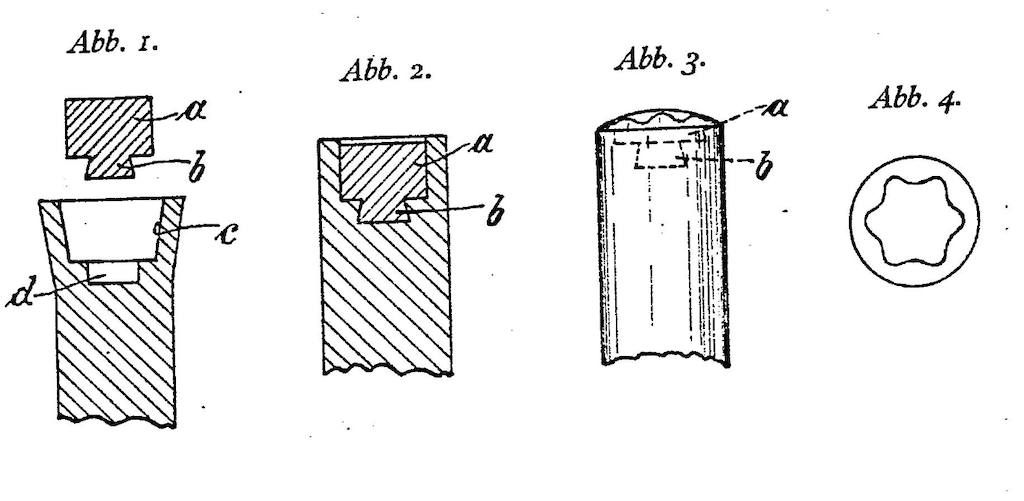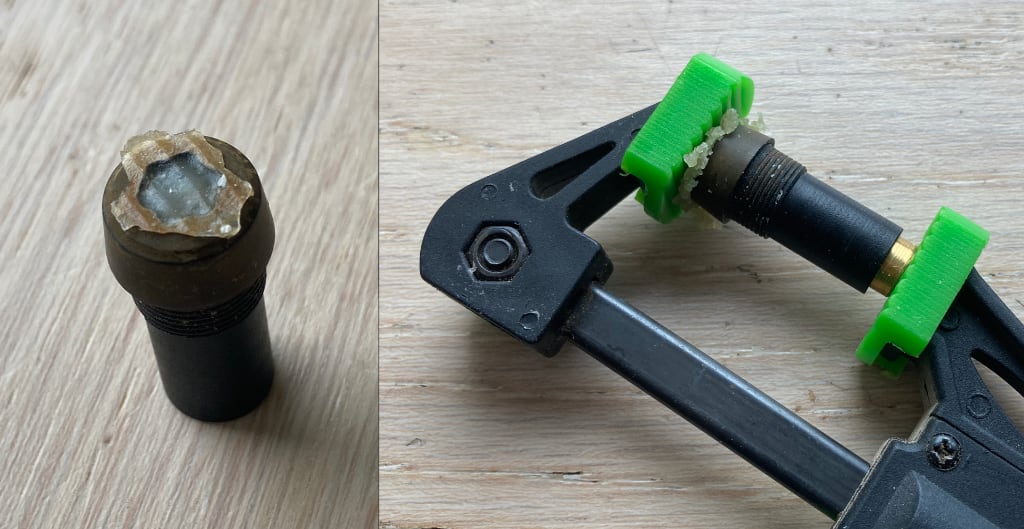New star for an old pen: Part 1
This posting is incomplete. I’ll come back and finish it off once I get the recipe to work properly.
One problem with old Montblanc pens is that they are occasionally missing the white star at the top of the cap. If you’re the type of collector who never uses your pens, then this is not a terribly bad thing. However, if you do want to write with it, then the hole through the top of the cap will have to be filled to prevent the nib from drying out.
If the pen is old enough, then it’s likely that the missing star was made of casein, an early type of plastic made from milk proteins. Luckily, it’s not difficult to make casein using some simple ingredients and a little effort, which means that it might be possible to bring the pen back to its original condition with the original materials.
Before starting the process, it’s important to ensure that the cap is cleaned thoroughly. This is to prevent old ink from colouring the casein when we put it into the hole later. It also may be necessary to carve out some material under the star so that when the soft casein is pushed in, it forms a mechanical lock. However, according to patent DE396083, the dovetail shape in the ebonite should already be there, a leftover from the original manufacturing process, as shown in the diagram from the patent, below. (Also see the additional comment at the bottom of this posting.)

Credits where credits are due
The recipe below is a modified version of the one shown in this video by Robert Murray-Smith.
He, in turn, got the recipe from Casein; Its Preparation and Technical Utilisation, written by Robert Scherer in 1906.
Basic Casein recipe
Ingredients
- 5 g skimmed milk powder
- 50 ml warm water (hot from the tap is fine)
- Vinegar (or lemon juice, or citric acid)
- Methanol or Ethanol (here in Denmark, this is sold as “sprit” in hardware stores)
- A glass container to work in (I bought a pickling jar for 10 DKK at a second hand store and took off the lid)
- If you want to be really geeky, you can use a thermometer… I don’t.
- Nearly-boiling water (at the end of the process)
Procedure
- Mix the 5 g of milk powder and the 50 ml of warm water in the container until the powder is dissolved
- Microwave the mixture for 10 to 30 seconds. You want the liquid to be hot, but not boiling.
- While stirring the milk, add a little vinegar until clumps form. You won’t need much vinegar, but don’t worry about overdoing it.
- Stir this around until the liquid separates into a clear-ish liquid and a clump of white goo. This is casein – but we need to purify it. (Although if you’ve ever made paneer, you might call it cheese. The procedure is roughly the same, but for paneer, I like to use high-fat milk.)
- Pour out the liquid and (assuming it’s not too hot), squeeze the casein ball to get as much water out of it as if feasible.
- Clean out your container (just a quick rinse and a wipe is fine)
- Crumble / pick at the casein and put the bits back into the jar, and pour in the methanol / ethanol to cover it. (It’s best to do this outside to keep the fumes out of your nose, and away from flames… just in case…)
- Stir the mixture, and use the back of the spoon to gently mash the casein against the side of the container for about 5 minutes. The goo will look different – more stringy – when you’re done. The liquid will also become coloured since it’s pulling unwanted stuff out of he goo.
- Drain off the methanol as much as possible.
- Add near-boiling water and gently start mashing the casein again. It will be sticky at the start. Keep mashing for 10 to 15 minutes. As the water starts to cool, the casein will become less sticky, so heat up the water again. You can do this by either by microwaving it occasionally or draining off the water and adding new hot water. I prefer the second of these because you’re pulling impurities out of the casein, and by replacing the water, you’re throwing out the stuff you don’t want.
- Eventually, you get a ball of casein with the consistency of well-chewed bubble gum. I knead this ball with my VERY CLEAN fingers to get the bubbles out and to get at least one clump of contiguous material.
- If you put that clump aside, and wait for a while (say, a couple of months), then it will turn into a hard clump of translucent, dingy yellow-ish colour plastic.
Congratulations! You just made bio-plastic. However, it won’t work for replacing the star on a Montblanc cap because of the light brownish colour and the translucence as can be seen on the left in the photo below.
If you look at the 1906 Scherer book he recommends that, if you’re making artificial ivory, you should add ivory powder to the mixture.
IMITATION IVORY
Casein; Its Preparation and Technical Utilisation, written by Robert Scherer (1906)
Milk curd, partly or wholly freed from its aqueous and fatty constituents and broken up into small lumps, is kneaded for about fifteen minutes in nearly boiling water. This treatment causes the separation of fatty or granular impurities, and leaves the casein in an almost perfectly pure state as a tough, sticky mass. Care must, however, be taken not to prolong the kneading beyond the proper stage, or the curd will be too soft and pappy. The product may then be pressed out into flat cakes or blocks of any desired shape.
The casein prepared in this way can be mixed with pigments or other materials, such as ivory dust, ground bone or ground porcelain, according to the character of the article it is intended to imitate. The prepared casein is stirred for about ten minutes in hot water, which causes it to soften; and it can then be incorporated with the necessary colouring matter or other ingredients, and the resulting plastic mass cast into moulds.
The curd, freed from whey, may also be kneaded in its own water of saturation, with a little more if necessary, at a temperature approaching the boiling point.. For this purpose, the curd should be broken into small pieces, this treatment facilitating the removal of fatty and other extraneous matter. By this means, the curd can be worked at a lower temperature and far more cheaply than by the first-named method, and also furnishes a tougher quality of casein. The colouring matters or other admixtures can be incorporated as soon as the fat has been washed out and the mass has been worked, thus saving a special mixing process. The temperature to which the curd containing the water of saturation is exposed, is about 120º to 175º F, according to the character of the curd. It is then worked or kneaded for about fifteen minutes, with or without the addition of a little more water, according to requirements, the water of saturation usually sufficing to make the mass plastic. The product is a tough, sticky mass which can be pressed into flat cakes or any other suitable shape.
Ivory is out of the question, so we need to find a substitute for that to start. A good friend of mine is a knife-maker, and he supplied me with a nice white piece of cow bone to try out.
My first attempt to turn the bone into powder was made by filing it down, catching the chips in a plastic container.

In the photo above, you can see my first attempt using the recipe I described above. The piece in the middle is the excess that came off the area around the “star” in the old Montblanc cap. You can easily see the bone chips in there, as well as the translucence of the casein when it’s thinner.
It’s obvious that I need a finer bone powder and more of it. So, I cut the side out of a small food container and use to to catch the dust coming off my disc sander. Then it was a matter of just sanding away a piece of bone. This resulted in a powder that was about the same consistency as the milk powder.

Failed recipes
As I mentioned at the top of this posting, I’m still working on the formula and the recipe. Here’s a list of the things I’ve tried and which have NOT worked.
- Making casein without the added powder. The colour is wrong, as shown above
- Adding chips from filing the cow bone. The particles are just too big.
- Adding 5 g of cow bone powder to the 5 g of milk powder at the start.
The two powders will separate when you add the water at the start, and the bone powder will never integrate into the casein. - Adding 1 g of cow bone powder to the methanol as part of Step 8.
I was hoping that the stringy bits would pick up the powder. They don’t. - Adding Sodium Bicarbonate (baking soda) (instead of cow bone powder) to the hot water after the methanol in Step 10. This causes a reaction that results in the casein not clumping.
- The latest attempt was to use my fingers to knead 1 g of cow bone powder to the casein clump in Step 10, above. I’m waiting on that one to dry out at the moment. The current results of that are shown in the photo below. The colour still looks wrong, and there are visible specks of bone in the mix. I also suspect that the star will become more translucent as it dries… more information to come on that. Notice that I use a brass insert to keep the pressure on the casein plug, but off the cap ends. The brass has a hole in it to avoid building up an air pocket inside.

Addenda
- If you want to harden the casein, then it should be immersed in formaldehyde, but this is difficult, if not impossible to obtain as a private person without a good excuse here in Denmark – so I haven’t tried it.
- That Simplo patent that I mentioned above describes how the Montblanc star was inserted into the cap. The ebonite was drilled with a circular hole, and the casein had the star shape and the flared bottom plug. When the star is inserted, the ebonite was heated and compressed to fill in around the star, locking it in and forming the 6-sided hole simultaneously.
Update
I’ve given up trying to fix missing stars with casein. I’ve now moved to a different method that has much better results, although it’s less traditional… That same finial that you see in the photos above is the one in the photos of the new posting.

